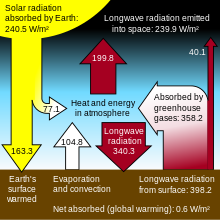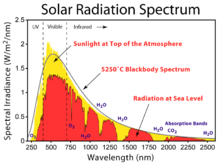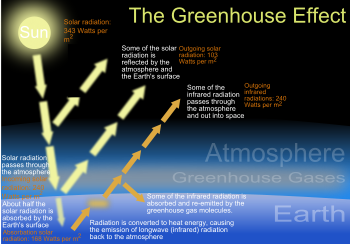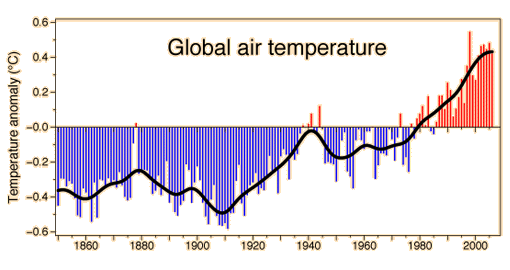Greenhouse effect Contributors To Increase Global Air Temperature-

A representation of the exchanges of energy between the source (the Sun), the Earth's surface, the Earth's atmosphere, and the ultimate sink outer space. The ability of the atmosphere to capture and recycle energy emitted by the Earth surface is the defining characteristic of the greenhouse effect.
The greenhouse effect is a process by which thermal radiation from a planetary surface is absorbed by atmospheric greenhouse gases, and is re-radiated in all directions. Since part of this re-radiation is back towards the surface, energy is transferred to the surface and the lower atmosphere. As a result, the temperature there is higher than it would be if direct heating by solar radiation were the only warming mechanism.
This mechanism is fundamentally different from that of an actual greenhouse, which works by isolating warm air inside the structure so that heat is not lost by convection.
The greenhouse effect was discovered by Joseph Fourier in 1824, first reliably experimented on by John Tyndall in 1858, and first reported quantitatively by Svante Arrhenius in 1896.
If an ideal thermally conductive blackbody was the same distance from the Sun as the Earth, it would have an expected blackbody temperature of 5.3 °C. However, since the Earth reflects about 30% (or 28%) of the incoming sunlight, the planet's actual blackbody temperature is about -18 or -19 °C, about 33°C below the actual surface temperature of about 14 °C or 15 °C. The mechanism that produces this difference between the actual temperature and the blackbody temperature is due to the atmosphere and is known as the greenhouse effect.
Global warming, a recent warming of the Earth's surface and lower atmosphere, is believed to be the result of a strengthening of the greenhouse effect mostly due to human-produced increases in atmospheric greenhouse gases.
Basic mechanism-
The Earth receives energy from the Sun in the form of visible light. This light is absorbed at the Earth's surface, and re-radiated as thermal radiation. Some of this thermal radiation is absorbed by the atmosphere, and re-radiated both upwards and downwards; that radiated downwards is absorbed by the Earth's surface. Thus the presence of the atmosphere results in the surface receiving more radiation than it would were the atmosphere absent; and it is thus warmer than it would otherwise be.
This highly simplified picture of the basic mechanism needs to be qualified in a number of ways, none of which affect the fundamental process.

The solar radiation spectrum for direct light at both the top of the Earth's atmosphere and at sea level
- The incoming radiation from the Sun is mostly in the form of visible light and nearby wavelengths, largely in the range 0.2 - 4 μm, corresponding to the Sun's radiative temperature of 6,000 K. Almost half the radiation is in the form of "visible" light, which our eyes are adapted to use.
- About 50% of the Sun's energy is absorbed at the Earth's surface and the rest is reflected or absorbed by the atmosphere. The reflection of light back into space - largely by clouds - does not much affect the basic mechanism; this light, effectively, is lost to the system
- The absorbed energy warms the surface. Simple presentations of the greenhouse effect, such as the idealized greenhouse model, show this heat being lost as thermal radiation. The reality is more complex: the atmosphere near the surface is largely opaque to thermal radiation (with important exceptions for "window" bands), and most heat loss from the surface is by sensible heat and latent heat transport. Radiative energy losses become increasingly important higher in the atmosphere largely because of the decreasing concentration of water vapor, an important greenhouse gas. It is more realistic to think of the greenhouse effect as applying to a "surface" in the mid-troposphere, which is effectively coupled to the surface by a lapse rate.
- Within the region where radiative effects are important the description given by the idealized greenhouse model becomes realistic: The surface of the Earth, warmed to a temperature around 255 K, radiates long-wavelength, infrared heat in the range 4 - 100 μm. At these wavelengths, greenhouse gases that were largely transparent to incoming solar radiation are more absorbent. Each layer of atmosphere with greenhouses gases absorbs some of the heat being radiated upwards from lower layers. To maintain its own equilibrium, it re-radiates the absorbed heat in all directions, both upwards and downwards. This results in more warmth below, while still radiating enough heat back out into deep space from the upper layers to maintain overall thermal equilibrium. Increasing the concentration of the gases increases the amount of absorption and re-radiation, and thereby further warms the layers and ultimately the surface below.
- The majority of the atmosphere—in particular, O2 and N2 which together form more than 99% of the dry atmosphere—is transparent to infrared radiation. Only triatomic (and higher) gases interact with infrared. However, due to intermolecular collisions, the energy absorbed and emitted by the greenhouse gases is effectively shared by the non-radiatively active gases.
- The simple picture assumes equilibrium. In the real world there is the diurnal cycle as well as seasonal cycles and weather. Solar heating only applies during daytime. During the night, the atmosphere cools somewhat, but not greatly, because its emissivity is low, and during the day the atmosphere warms. Diurnal temperature changes decrease with height in the atmosphere.
Role in climate change-
Global warming

The Keeling Curve of atmospheric CO2 concentrations measured at Mauna Loa Observatory.
Strengthening of the greenhouse effect through human activities is known as the enhanced (or anthropogenic) greenhouse effect. This increase in radiative forcing from human activity is attributable mainly to increased atmospheric carbon dioxide levels.
CO2 is produced by fossil fuel burning and other activities such as cement production and tropical deforestation. Measurements of CO2 from the Mauna Loa observatory show that concentrations have increased from about 313 ppm in 1960 to about 389 ppm in 2010. The current observed amount of CO2 The effect of combustion-produced carbon dioxide on the global climate, a special case of the greenhouse effect first described in 1896 by Svante Arrhenius, has also been called the Callendar effect. exceeds the geological record maxima (~300 ppm) from ice core data.
Because it is a greenhouse gas, elevated CO2 levels contribute to additional absorption and emission of thermal infrared in the atmosphere, which produce net warming. According to the latest Assessment Report from the Intergovernmental Panel on Climate Change, "most of the observed increase in globally averaged temperatures since the mid-20th century is very likely due to the observed increase in anthropogenic greenhouse gas concentrations".
Over the past 800,000 years, ice core data shows unambiguously that carbon dioxide has varied from values as low as 180 parts per million (ppm) to the pre-industrial level of 270ppm. Paleoclimatologists consider variations in carbon dioxide to be a fundamental factor in controlling climate variations over this time scale.
Top emitters-
In 2005, the world's top-20 emitters comprised 80% of total GHG emissions (PBL, 2010. See notes for the following table). Tabulated below are the top-5 emitters for the year 2005 (MNP, 2007). The second column is the country's or region's share of the global total of annual emissions. The third column is the country's or region's average annual per capita emissions, in tonnes of GHG per head of population:
| Country or region | % of global total annual emissions | Tonnes of GHG per capita |
|---|---|---|
| Chinab | 17 % | 5.8 |
| United Statesa | 16 % | 24.1 |
| European Union-27a | 11 % | 10.6 |
| Indonesiac | 6 % | 12.9 |
| India | 5 % | 2.1 |
The distinction between the greenhouse effect and real greenhouses-

A modern Greenhouse in RHS Wisley
The "greenhouse effect" is named by analogy to greenhouses but this is a misnomer. The greenhouse effect and a real greenhouse are similar in that they both limit the rate of thermal energy flowing out of the system, but the mechanisms by which heat is retained are different. A greenhouse works primarily by preventing absorbed heat from leaving the structure through convection, i.e. sensible heat transport. The greenhouse effect heats the earth because greenhouse gases absorb outgoing radiative energy and re-emit some of it back towards earth.
A greenhouse is built of any material that passes sunlight, usually glass, or plastic. It mainly heats up because the Sun warms the ground inside, which then warms the air in the greenhouse. The air continues to heat because it is confined within the greenhouse, unlike the environment outside the greenhouse where warm air near the surface rises and mixes with cooler air aloft. This can be demonstrated by opening a small window near the roof of a greenhouse: the temperature will drop considerably. It has also been demonstrated experimentally (R. W. Wood, 1909) that a "greenhouse" with a cover of rock salt (which is transparent to infra red) heats up an enclosure similarly to one with a glass cover. Thus greenhouses work primarily by preventing convective cooling.
In the greenhouse effect, rather than retaining (sensible) heat by physically preventing movement of the air, greenhouse gases act to warm the Earth by re-radiating some of the energy back towards the surface. This process may exist in real greenhouses, but is comparatively unimportant there.
Bodies other than Earth-
In our solar system, Mars, Venus, and the moon Titan also exhibit greenhouse effects. Titan has an anti-greenhouse effect, in that its atmosphere absorbs solar radiation but is relatively transparent to infrared radiation. Pluto also exhibits behavior superficially similar to the anti-greenhouse effect.
A runaway greenhouse effect occurs if positive feedbacks lead to the evaporation of all greenhouse gases into the atmosphere. A runaway greenhouse effect involving carbon dioxide and water vapor is thought to have occurred on Venus.
Greenhouse gas-

Simple diagram of greenhouse effect.
A greenhouse gas (sometimes abbreviated GHG) is a gas in an atmosphere that absorbs and emits radiation within the thermal infrared range. This process is the fundamental cause of the greenhouse effect. The primary greenhouse gases in the Earth's atmosphere are water vapor, carbon dioxide, methane, nitrous oxide, and ozone. In the Solar System, the atmospheres of Venus, Mars, and Titan also contain gases that cause greenhouse effects. Greenhouse gases greatly affect the temperature of the Earth; without them, Earth's surface would be on average about 33 °C (59 °F) colder than at present.
Since the beginning of the Industrial revolution, the burning of fossil fuels has increased the levels of carbon dioxide in the atmosphere from 280ppm to 390ppm.
Greenhouse gas emissions-
Measurements from Antarctic ice cores show that before industrial emissions started atmospheric CO2 levels were about 280 parts per million by volume (ppmv), and stayed between 260 and 280 during the preceding ten thousand years. Carbon dioxide concentrations in the atmosphere have gone up by approximately 35 percent since the 1900s, rising from 280 parts per million by volume to 387 parts per million in 2009. One study using evidence from stomata of fossilized leaves suggests greater variability, with carbon dioxide levels above 300 ppm during the period seven to ten thousand years ago, though others have argued that these findings more likely reflect calibration or contamination problems rather than actual CO2 variability. Because of the way air is trapped in ice (pores in the ice close off slowly to form bubbles deep within the firn) and the time period represented in each ice sample analyzed, these figures represent averages of atmospheric concentrations of up to a few centuries rather than annual or decadal levels.

Recent year-to-year increase of atmospheric CO2.
Since the beginning of the Industrial Revolution, the concentrations of most of the greenhouse gases have increased. For example, the concentration of carbon dioxide has increased by about 36% to 380 ppmv, or 100 ppmv over modern pre-industrial levels. The first 50 ppmv increase took place in about 200 years, from the start of the Industrial Revolution to around 1973; however the next 50 ppmv increase took place in about 33 years, from 1973 to 2006.
Recent data also shows that the concentration is increasing at a higher rate. In the 1960s, the average annual increase was only 37% of what it was in 2000 through 2007.
The other greenhouse gases produced from human activity show similar increases in both amount and rate of increase. Many observations are available online in a variety of Atmospheric Chemistry Observational Databases.
Projections-
Based on then-current energy policies, Rogner et al. (2007) projected that energy-related CO2 emissions in 2030 would be 40-110% higher than in 2000. Two-thirds of this increase was projected to come from non-Annex I countries. Per capita emissions in Annex I countries were still projected to remain substantially higher than per capita emissions in non-Annex I countries. Projections consistently showed a 25-90% increase in the Kyoto gases (carbon dioxide, methane, nitrous oxide, sulphur hexafluoride) compared to 2000.
Global warming potential-
The global warming potential (GWP) depends on both the efficiency of the molecule as a greenhouse gas and its atmospheric lifetime. GWP is measured relative to the same mass of CO2 and evaluated for a specific timescale. Thus, if a gas has a high radiative forcing but also a short lifetime, it will have a large GWP on a 20 year scale but a small one on a 100 year scale. Conversely, if a molecule has a longer atmospheric lifetime than CO2 its GWP will increase with the timescale considered.
Images for greenhouse effect-
Carbon dioxide has a variable atmospheric lifetime, and cannot be specified precisely. Recent work indicates that recovery from a large input of atmospheric CO2 from burning fossil fuels will result in an effective lifetime of tens of thousands of years. Carbon dioxide is defined to have a GWP of 1 over all time periods.
Methane has an atmospheric lifetime of 12 ± 3 years and a GWP of 72 over 20 years, 25 over 100 years and 7.6 over 500 years. The decrease in GWP at longer times is because methane is degraded to water and CO2 through chemical reactions in the atmosphere.
An issue of major concern is the possible effect of the burning of fossil fuels and other contributers to the increase of carbon dioxide in the atmosphere. The action of carbon dioxide and other greenhouse gases in trapping infrared radiation is called the greenhouse effect. It may measurably increase the overall average temperature of the Earth, which could have disastrous consequences. Sometimes the effects of the greenhouse effect are stated in terms of the albedo of the Earth, the overall average reflection coefficient.

This graphic of the global air temperature was posted by Phil Jones on behalf of the Climatic Research Unit, UK.
Contributers to Greenhouse Effect-
Those gas molecules in the Earth's atmosphere with three or more atoms are called "greenhouse gases" because they can capture outgoing infrared energy from the Earth, thereby warming the planet. The greenhouse gases include water vapor with three atoms (H2O), ozone (O3), carbon dioxide (CO2), and methane (CH4). Also, trace quantities of chloro-fluoro-carbons (CFC's) can have a disproportionately large effect.

To attempt to quantify the effects of greenhouse gases on the global temperature, climatologists use the "radiative forcing" of the current atmospheric content of these gases.
From Wikipedia-
No comments:
Post a Comment